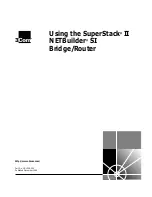
7-2
Catalyst 6500 Series Switch Software Configuration Guide—Release 8.7
OL-8978-04
Chapter 7 Configuring Spanning Tree
Understanding How Spanning Tree Protocols Work
Understanding How Spanning Tree Protocols Work
This section describes the specific functions that are common to all spanning-tree protocols. Cisco’s
proprietary spanning-tree protocols, PVST+ and MISTP, are based on IEEE 802.1D STP. (See the
“Understanding How PVST+ and MISTP Modes Work” section on page 7-12
for information about
PVST+ and MISTP.) The 802.1D STP is a Layer 2 management protocol that provides path redundancy
in a network while preventing undesirable loops. All spanning-tree protocols use an algorithm that
calculates the best loop-free path through the network.
STP uses a distributed algorithm that selects one bridge of a redundantly connected network as the root
of a spanning tree-connected active topology. STP assigns roles to each port depending on what the
port’s function is in the active topology. Port roles are as follows:
•
Root—A forwarding port that is elected for the spanning-tree topology
•
Designated—A forwarding port that is elected for every switched LAN segment
•
Alternate—A blocked port providing an alternate path to the root port in the spanning tree
•
Backup—A blocked port in a loopback configuration
The switches that have ports with these assigned roles are called the root or designated switches. For
more information, see the
“Understanding How a Switch Becomes the Root Switch” section on page 7-3
.
In Ethernet networks, only one active path may exist between any two stations. Multiple active paths
between stations can cause loops in the network. When loops occur, some switches recognize the stations
on both sides of the switch. This situation causes the forwarding algorithm to malfunction allowing the
duplicate frames to be forwarded.
The spanning-tree algorithms provide path redundancy by defining a tree that spans all of the switches
in an extended network and then forces certain redundant data paths into a standby (blocked) state. At
regular intervals, the switches in the network send and receive spanning-tree packets that they use to
identify the path. If one network segment becomes unreachable, or if the spanning-tree costs change, the
spanning-tree algorithm reconfigures the spanning-tree topology and reestablishes the link by activating
the standby path.
The spanning-tree operation is transparent to end stations, which do not detect whether they are
connected to a single LAN segment or a switched LAN of multiple segments.
These sections describe the STP:
•
Understanding How a Topology is Created, page 7-3
•
Understanding How a Switch Becomes the Root Switch, page 7-3
•
Understanding How Bridge Protocol Data Units Work, page 7-4
•
Calculating and Assigning Port Costs, page 7-4
•
Spanning-Tree Port States, page 7-6
















































